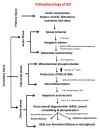Spinal Cord Injury: Pathophysiology, Multimolecular Interactions, and Underlying Recovery Mechanisms
- PMID: 33066029
- PMCID: PMC7589539
- DOI: 10.3390/ijms21207533
Spinal Cord Injury: Pathophysiology, Multimolecular Interactions, and Underlying Recovery Mechanisms
Abstract
Spinal cord injury (SCI) is a destructive neurological and pathological state that causes major motor, sensory and autonomic dysfunctions. Its pathophysiology comprises acute and chronic phases and incorporates a cascade of destructive events such as ischemia, oxidative stress, inflammatory events, apoptotic pathways and locomotor dysfunctions. Many therapeutic strategies have been proposed to overcome neurodegenerative events and reduce secondary neuronal damage. Efforts have also been devoted in developing neuroprotective and neuro-regenerative therapies that promote neuronal recovery and outcome. Although varying degrees of success have been achieved, curative accomplishment is still elusive probably due to the complex healing and protective mechanisms involved. Thus, current understanding in this area must be assessed to formulate appropriate treatment modalities to improve SCI recovery. This review aims to promote the understanding of SCI pathophysiology, interrelated or interlinked multimolecular interactions and various methods of neuronal recovery i.e., neuroprotective, immunomodulatory and neuro-regenerative pathways and relevant approaches.
Keywords: neuro-regeneration; neurodegeneration; neuroprotection; primary injury; secondary injury; spinal cord injury.
Conflict of interest statement
The authors declare no conflict of interest.
Figures









References
-
- Htwe O., Hussain R.I., Naicker A.S. Challenges in Managing Severe Lower Limb Spasticity Associated with Bilateral Hip Joints Subluxation. Eur. J. Gen. Med. 2016;13:165–167.
-
- Ohnmar H., Das S., Naicker A.S. An interesting case of Autonomic Dysreflexia. Clin. Ter. 2009;160:371. - PubMed
Publication types
MeSH terms
Grants and funding
LinkOut - more resources
Full Text Sources
Medical

